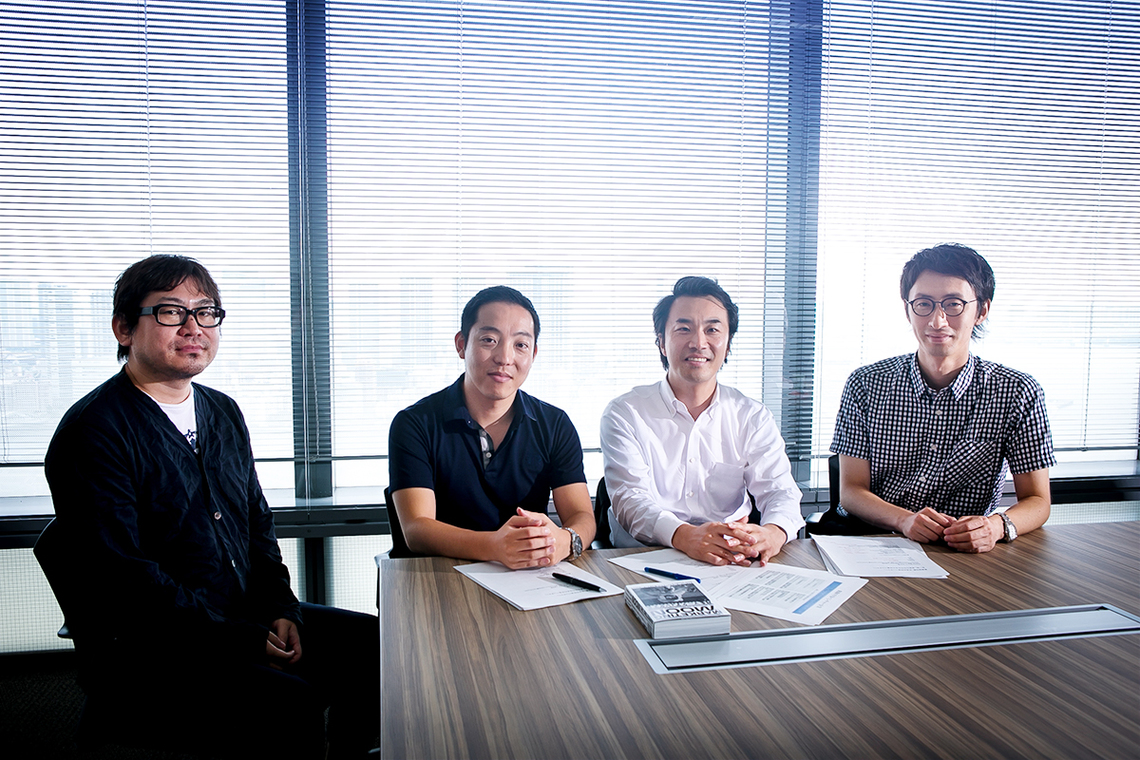The space business has been led by Europe and the United States until now. Space ventures are also emerging one after another in Japan.
In this "Introduction to Space" session, Dentsu Inc.'s Shin Sasagawa and Toshihiro Katayama interviewed Hidetake Aoki of Global Brain, a member of the Cabinet Office's Space Policy Committee who has provided extensive cooperation in Dentsu Inc.'s space-related projects, and Masayasu Ishida of A.T. Carney.

From left: Mr. Sasagawa of Dentsu Inc., Mr. Aoki of Global Brain, Mr. Ishida of A.T. Carney, and Mr. Katayama of Dentsu Inc.
Google is a sponsor! "The same thing is happening in space."
Sasagawa: As members of the Cabinet Office's Space Policy Committee, when did your involvement with space begin?
Aoki: I've been involved for 20 years. I studied aerospace engineering at a university in the United States and conducted joint research with NASA during my graduate school days. After that, I joined Mitsubishi Electric and was involved in the development of Japan's first spacecraft, Kounotori.
After that, I began researching space business for my MBA and realized there were almost no Japanese people proficient in both business and technology. So, a few years ago, I started working as a space evangelist, promoting private space business.
Ishida: In terms of space industry experience, I haven't been at it as long. Probably about the same as Mr. Sasagawa. My main job is as a management consultant, specializing for many years in fields like high-tech/IT and automotive. My first involvement with space was participating pro bono in the world's first private lunar exploration race, the " Google Lunar XPRIZE," around 2011.
I was hospitalized at the time and happened to buy a copy of Nikkei Science that featured the story. I was so intrigued that I contacted them immediately after being discharged.
What struck me was Google sponsoring space exploration. While we see more players from diverse industries entering fields like the automotive sector, I realized, "The same thing is happening in space." Since then, I've engaged with space through various activities: lectures, writing, government committee work, and my main profession.

©HAKUTO
HAKUTO, Japan's sole team participating in the "Google Lunar XPRIZE." A $30 million international prize race for lunar robotic exploration.
The Third Space Venture Boom. Space Business is on the Verge of Explosive Evolution
Aoki: About five years ago, Japan didn't even have the term "space business." Space development meant state-led projects. In recent years, we've seen a shift away from dependence on government contracts, and space ventures have begun emerging one after another domestically.
The same trend is seen globally, with a surge in the 2010s. Currently, there are about 1,000 space ventures worldwide, marking what is called the Third Space Venture Boom.
Ishida: As is true for any industry, the dawn of a new sector brings diverse concepts, players, and technologies, with signs of something emerging everywhere. The current space business is in precisely this state, and I feel it follows the classic pattern of an industry transitioning to a new stage.
Aoki: The traditional space industry value chain consisted of three stages: "build satellites," "launch them," and "provide services." It only had a rough mapping, such as whether it was for communications, broadcasting, Earth observation, or planetary exploration.
Now, with companies like Google and Facebook entering the space, and entirely new business models and services emerging, the situation is quite chaotic, isn't it?
Ishida: In my line of work, I often create overview diagrams to map out which players are in which industry layers and organize the industrial structure. However, this becomes difficult during an industry's dawn or transformation phase. The space industry in 2016 is precisely in that phase. It's a situation where no one worldwide understands it accurately, and interpretations vary from person to person.

Three Space Venture Booms to Keep in Mind
Katayama: If this is the third boom, what about the first and second?
Aoki: The first space venture boom was in the 1980s. Among the companies born then was Orbital Sciences (now Orbital ATK), founded by graduates of Harvard Business School.
It's a company that manufactures and launches satellites, famous for transporting supplies to the International Space Station. Today, it's a publicly traded company boasting sales in the hundreds of billions of yen.
The second boom was in the early 2000s. This was an era when advances in IT made it possible to apply that technology to space development. At the same time, the hot topic in the US around this time was the space tourism business, and Virgin Galactic was a company born precisely during this era. The same is true for Elon Musk's SpaceX, which develops and launches rockets and spacecraft.

Ishida: When it comes to the difference between the second and third booms, I think the second boom in the United States was mainly about SpaceX. It was about how to make access to space easier.
Blue Origin, founded by Amazon.com co-founder Jeff Bezos with the goal of manned spaceflight, was also established in the early 2000s.
I think the characteristics of the third boom are the development of small satellite-specific rockets to make access even easier, and the rapid increase in the number of people thinking about what to do in space once access becomes easier, in other words, applications and services.
Traditional? New? The Two Major Players in the Space Industry
Aoki: Players in the space industry broadly fall into two categories. One is traditional space. In the US, this includes NASA and Boeing; in Japan, it's JAXA, heavy industry manufacturers, and major electronics companies—the traditional players in this industry.
The other is New Space. This includes rapidly growing space venture companies, primarily those that raise private funding and take risks themselves.
However, the barrier between traditional and new space is disappearing, and they are beginning to collaborate. From the new space perspective, lacking sufficient personnel, assets, and only possessing some technologies, they can leverage the resources of large traditional corporations.
Traditional players can capture new demand by working with New Space. This creates a win-win situation where the entire space industry thrives.

Katayama: What led to the emergence of new players from traditional ones, and what's driving the rapid growth of these new players?
Aoki: Several factors exist, but the lowered financial barrier is significant. This began during the second boom. For example, satellites once cost hundreds of billions of yen, but miniaturization now allows them to be built for tens of millions to hundreds of millions of yen per unit.
Second, space itself has increasingly been recognized as an industry. As robotics and IT boomed, and new fields like healthcare, medicine, and neuroscience gained attention, space remained the last frontier. Investors recognized this early, and capital-rich entrepreneurs are now entering the space.
Ishida: Technologies like electronics, IT/big data, AI, and robotics—which were once seen as distant from the space industry—are now being utilized. They're merging with traditional space technology, and some people believe this convergence could spark something new in space business.
Aoki: Third is the tremendous success of SpaceX. When there's a pioneer, followers emerge thinking, "Hey, I can do that too!" When a big player creates a precedent, others jump in. It's the same with IT ventures, right?
Ishida: Mr. Takeshi Hakamada of HAKUTO, one of Japan's new space companies, mentioned that his motivation to "start a business in space" came from hearing directly from a winning team member of the Ansari X Prize* during a lecture at his university while studying in the US. Hearing from successful people is the best, because the reality is different.
*Ansari X Prize... A contest run by the X Prize Foundation to compete for the first private manned suborbital spaceflight. Held in the US in 2004, the $10 million prize was awarded to SpaceShipOne, the first to meet the specified conditions.

2016 is the year the leading players in the space business will be decided.
Sasakawa: So the success of the second boom created the third, right?
Ishida: I see the roughly 10-year shift from the second to the third boom as something that was, to a certain extent, anticipated. When you go to the U.S., you hear the term "commercial space" more often than "new space."
This concept originated in Europe in the 1980s, aiming to shift space development toward private-sector leadership. About 10 to 15 years ago, the U.S. also made a significant pivot toward this commercial space approach, particularly in near-Earth space.
Sasagawa: Why is that?
Ishida: The global space industry is now estimated to be worth 30 trillion yen. Of this, government demand accounts for just under 8 trillion yen, with the remainder mostly satellite broadcasting and communications. While the US accounts for about half of that 8 trillion yen in government demand, even the US doesn't have an abundant space budget, making the utilization of private sector capabilities essential.
The first to make a spectacular splash was the aforementioned SpaceX. NASA, the government agency, contracted several private companies, including SpaceX, to transport cargo to the International Space Station (ISS), adopting a method where NASA purchases the transportation service. This plan was announced in 2006.
The overall picture is one of simultaneous, multi-pronged movements: the desire and prevailing sentiment among nations, particularly the US, to leverage private sector capabilities; players like entrepreneurs and investors who saw this as an opportunity and boldly challenged it with new technologies and capital; and major corporations that have long driven the space business. The timing of these movements aligned, leading to the current state.
Aoki: The time is ripe. Globally, the players in the space business are almost all in place. By the end of 2016, the leading group should be firmly established.
Next time, we'll delve into the four latest trends in space!

















